warning YAMAHA VMAX 2001 User Guide
[x] Cancel search | Manufacturer: YAMAHA, Model Year: 2001, Model line: VMAX, Model: YAMAHA VMAX 2001Pages: 110, PDF Size: 11.88 MB
Page 27 of 110
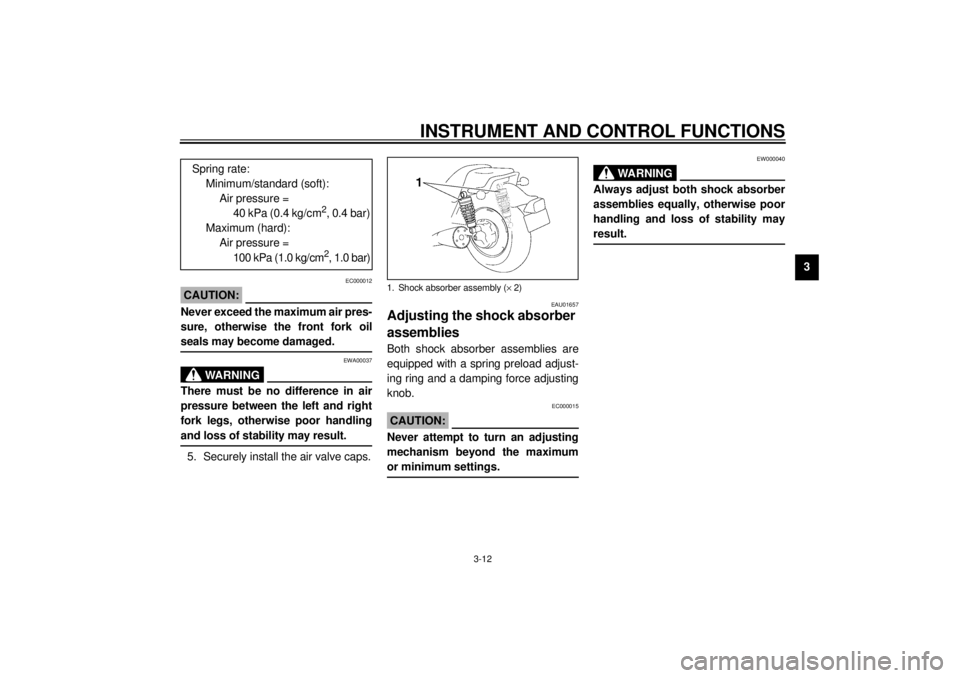
INSTRUMENT AND CONTROL FUNCTIONS
3-12
3
EC000012
CAUTION:@ Never exceed the maximum air pres-
sure, otherwise the front fork oil
seals may become damaged. @
EWA00037
WARNING
@ There must be no difference in air
pressure between the left and right
fork legs, otherwise poor handling
and loss of stability may result. @5. Securely install the air valve caps.
EAU01657
Adjusting the shock absorber
assemblies Both shock absorber assemblies are
equipped with a spring preload adjust-
ing ring and a damping force adjusting
knob.
EC000015
CAUTION:@ Never attempt to turn an adjusting
mechanism beyond the maximum
or minimum settings. @
EW000040
WARNING
@ Always adjust both shock absorber
assemblies equally, otherwise poor
handling and loss of stability may
result. @
Spring rate:
Minimum/standard (soft):
Air pressure =
40 kPa (0.4 kg/cm
2, 0.4 bar)
Maximum (hard):
Air pressure =
100 kPa (1.0 kg/cm2, 1.0 bar)
1. Shock absorber assembly (´ 2)
E_3lr.book Page 12 Wednesday, November 22, 2000 4:10 PM
Page 31 of 110
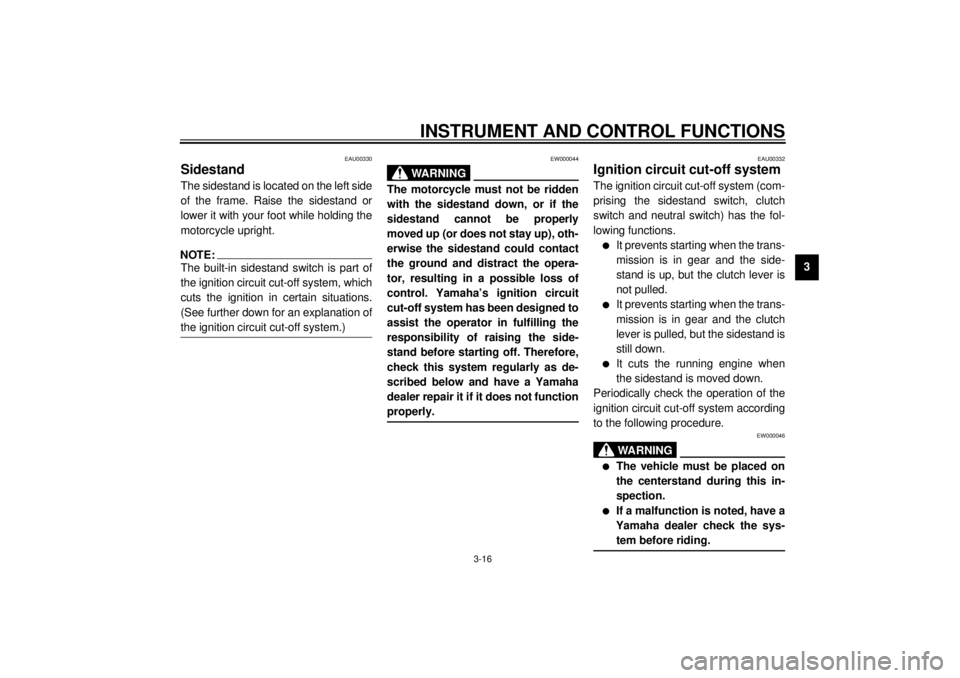
INSTRUMENT AND CONTROL FUNCTIONS
3-16
3
EAU00330
Sidestand The sidestand is located on the left side
of the frame. Raise the sidestand or
lower it with your foot while holding the
motorcycle upright.NOTE:@ The built-in sidestand switch is part of
the ignition circuit cut-off system, which
cuts the ignition in certain situations.
(See further down for an explanation of
the ignition circuit cut-off system.) @
EW000044
WARNING
@ The motorcycle must not be ridden
with the sidestand down, or if the
sidestand cannot be properly
moved up (or does not stay up), oth-
erwise the sidestand could contact
the ground and distract the opera-
tor, resulting in a possible loss of
control. Yamaha’s ignition circuit
cut-off system has been designed to
assist the operator in fulfilling the
responsibility of raising the side-
stand before starting off. Therefore,
check this system regularly as de-
scribed below and have a Yamaha
dealer repair it if it does not function
properly. @
EAU00332
Ignition circuit cut-off system The ignition circuit cut-off system (com-
prising the sidestand switch, clutch
switch and neutral switch) has the fol-
lowing functions.l
It prevents starting when the trans-
mission is in gear and the side-
stand is up, but the clutch lever is
not pulled.
l
It prevents starting when the trans-
mission is in gear and the clutch
lever is pulled, but the sidestand is
still down.
l
It cuts the running engine when
the sidestand is moved down.
Periodically check the operation of the
ignition circuit cut-off system according
to the following procedure.
EW000046
WARNING
@ l
The vehicle must be placed on
the centerstand during this in-
spection.
l
If a malfunction is noted, have a
Yamaha dealer check the sys-
tem before riding.
@
E_3lr.book Page 16 Wednesday, November 22, 2000 4:10 PM
Page 35 of 110
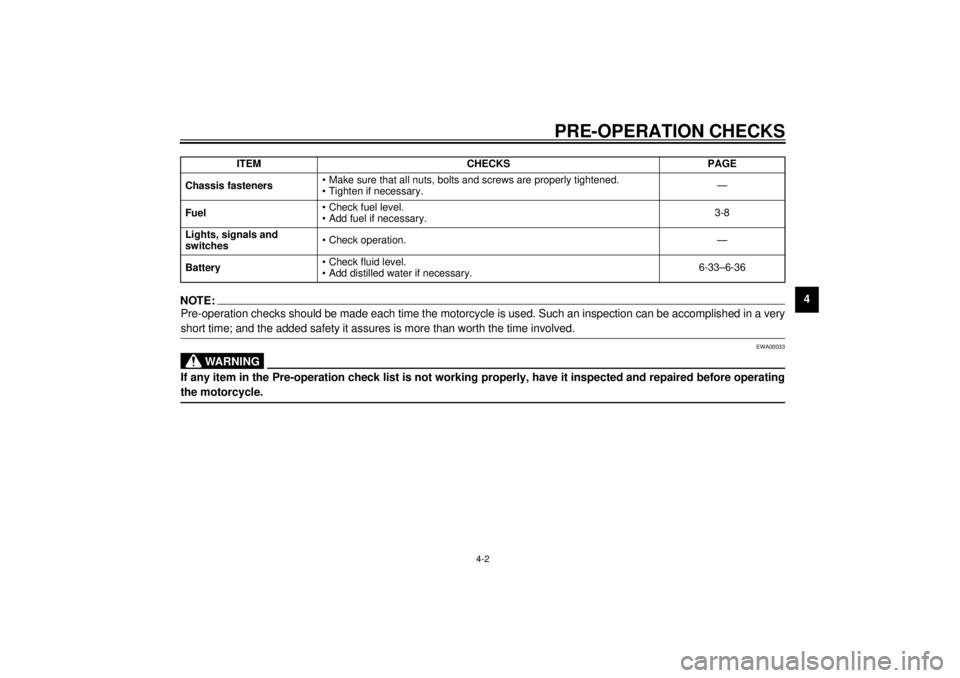
PRE-OPERATION CHECKS
4-2
4
NOTE:@ Pre-operation checks should be made each time the motorcycle is used. Such an inspection can be accomplished in a very
short time; and the added safety it assures is more than worth the time involved. @
EWA00033
WARNING
@ If any item in the Pre-operation check list is not working properly, have it inspected and repaired before operating
the motorcycle. @ Chassis fasteners• Make sure that all nuts, bolts and screws are properly tightened.
• Tighten if necessary.—
Fuel• Check fuel level.
• Add fuel if necessary.3-8
Lights, signals and
switches• Check operation. —
Battery• Check fluid level.
• Add distilled water if necessary.6-33–6-36 ITEM CHECKS PAGE
E_3lr.book Page 2 Wednesday, November 22, 2000 4:10 PM
Page 38 of 110

5-1
5
EAU00372
5-OPERATION AND IMPORTANT RIDING POINTS
EAU00373
WARNING
@ l
Become thoroughly familiar
with all operating controls and
their functions before riding.
Consult a Yamaha dealer re-
garding any control or function
that you do not thoroughly un-
derstand.
l
Never start the engine or oper-
ate it in a closed area for any
length of time. Exhaust fumes
are poisonous, and inhaling
them can cause loss of con-
sciousness and death within a
short time. Always make sure
that there is adequate ventila-
tion.
l
Before starting out, make sure
that the sidestand is up. If the
sidestand is not raised com-
pletely, it could contact the
ground and distract the opera-
tor, resulting in a possible loss
of control.
@
EAU01627
Starting a cold engine In order for the ignition circuit cut-off
system to enable starting, one of the
following conditions must be met:l
The transmission is in the neutral
position.
l
The transmission is in gear with
the clutch lever pulled and the
sidestand up.
EW000054
WARNING
@ l
Before starting the engine,
check the function of the igni-
tion circuit cut-off system ac-
cording to the procedure
described on page 3-16.
l
Never ride with the sidestand
down.
@1. Turn the key to “ON” and make
sure that the engine stop switch is
set to “ ”.
EC000035
CAUTION:@ If the fuel level warning light comes
on, check the fuel level, and, if nec-
essary, refuel as soon as possible. @2. Shift the transmission into the neu-
tral position.NOTE:@ When the transmission is in the neutral
position, the neutral indicator light
should be on, otherwise have a
Yamaha dealer check the electrical cir-
cuit. @3. Turn the starter (choke) on and
completely close the throttle. (See
page 3-8 for starter (choke) opera-
tion.)
4. Start the engine by pushing the
start switch.
E_3lr.book Page 1 Wednesday, November 22, 2000 4:10 PM
Page 39 of 110
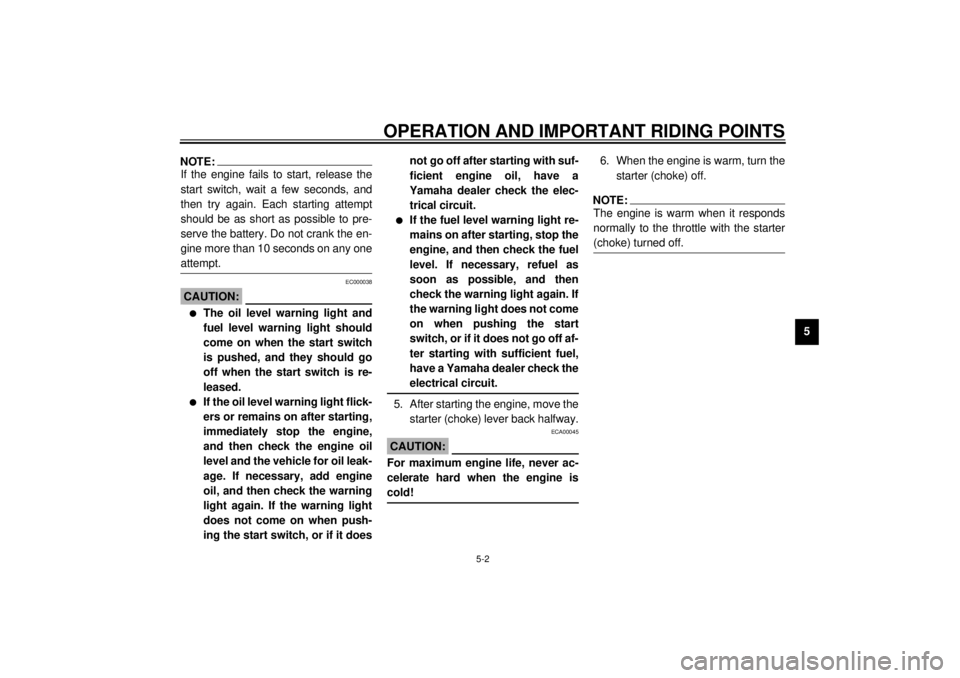
OPERATION AND IMPORTANT RIDING POINTS
5-2
5
NOTE:@ If the engine fails to start, release the
start switch, wait a few seconds, and
then try again. Each starting attempt
should be as short as possible to pre-
serve the battery. Do not crank the en-
gine more than 10 seconds on any one
attempt. @
EC000038
CAUTION:@ l
The oil level warning light and
fuel level warning light should
come on when the start switch
is pushed, and they should go
off when the start switch is re-
leased.
l
If the oil level warning light flick-
ers or remains on after starting,
immediately stop the engine,
and then check the engine oil
level and the vehicle for oil leak-
age. If necessary, add engine
oil, and then check the warning
light again. If the warning light
does not come on when push-
ing the start switch, or if it doesnot go off after starting with suf-
ficient engine oil, have a
Yamaha dealer check the elec-
trical circuit.
l
If the fuel level warning light re-
mains on after starting, stop the
engine, and then check the fuel
level. If necessary, refuel as
soon as possible, and then
check the warning light again. If
the warning light does not come
on when pushing the start
switch, or if it does not go off af-
ter starting with sufficient fuel,
have a Yamaha dealer check the
electrical circuit.
@5. After starting the engine, move the
starter (choke) lever back halfway.
ECA00045
CAUTION:@ For maximum engine life, never ac-
celerate hard when the engine is
cold! @
6. When the engine is warm, turn the
starter (choke) off.NOTE:@ The engine is warm when it responds
normally to the throttle with the starter
(choke) turned off. @
E_3lr.book Page 2 Wednesday, November 22, 2000 4:10 PM
Page 42 of 110

OPERATION AND IMPORTANT RIDING POINTS
5-5
5
EAU00442
0–150 kml
Avoid prolonged operation above
4,500 r/min.
l
After every hour of operation, stop
the engine, and then let it cool for
five to ten minutes.
l
Vary the engine speed from time
to time. Do not operate the engine
at one set throttle position.
150–500 km
l
Avoid prolonged operation above
5,500 r/min.
l
Rev the engine freely through the
gears, but do not use full throttle at
any time.
500–1,000 km
l
Avoid prolonged full-throttle oper-
ation.
l
Avoid prolonged operation above
6,500 r/min.
EC000056
CAUTION:@ After 1,000 km of operation, the en-
gine oil and final gear oil must be
changed, and the oil filter cartridge
replaced.@1,000 km and beyond
The vehicle can now be operated
normally.
EC000053
CAUTION:@ l
Keep the engine speed out of
the tachometer red zone.
l
If any engine trouble should
occur during the engine break-
in period, immediately have a
Yamaha dealer check the
vehicle.
@
EAU00460
Parking When parking, stop the engine, and
then remove the key from the main
switch.
EW000058
WARNING
@ l
Since the engine and exhaust
system can become very hot,
park in a place where pedestri-
ans or children are not likely to
touch them.
l
Do not park on a slope or on
soft ground, otherwise the
motorcycle may overturn.
@
E_3lr.book Page 5 Wednesday, November 22, 2000 4:10 PM
Page 44 of 110
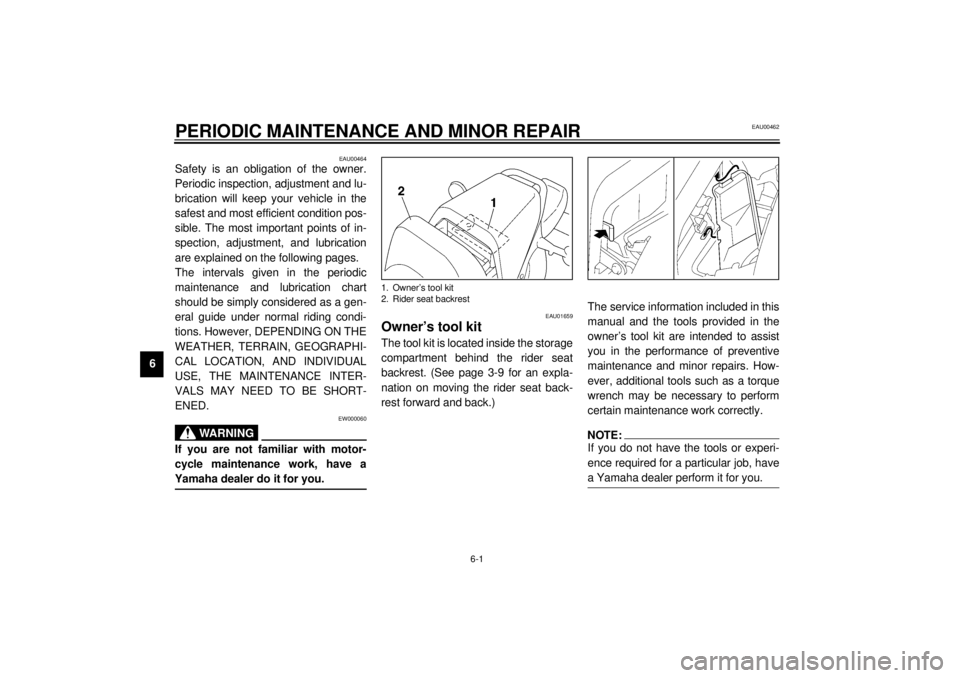
6-1
6
EAU00462
6-PERIODIC MAINTENANCE AND MINOR REPAIR
EAU00464
Safety is an obligation of the owner.
Periodic inspection, adjustment and lu-
brication will keep your vehicle in the
safest and most efficient condition pos-
sible. The most important points of in-
spection, adjustment, and lubrication
are explained on the following pages.
The intervals given in the periodic
maintenance and lubrication chart
should be simply considered as a gen-
eral guide under normal riding condi-
tions. However, DEPENDING ON THE
WEATHER, TERRAIN, GEOGRAPHI-
CAL LOCATION, AND INDIVIDUAL
USE, THE MAINTENANCE INTER-
VALS MAY NEED TO BE SHORT-
ENED.
EW000060
WARNING
@ If you are not familiar with motor-
cycle maintenance work, have a
Yamaha dealer do it for you. @
EAU01659
Owner’s tool kit The tool kit is located inside the storage
compartment behind the rider seat
backrest. (See page 3-9 for an expla-
nation on moving the rider seat back-
rest forward and back.)The service information included in this
manual and the tools provided in the
owner’s tool kit are intended to assist
you in the performance of preventive
maintenance and minor repairs. How-
ever, additional tools such as a torque
wrench may be necessary to perform
certain maintenance work correctly.
NOTE:@ If you do not have the tools or experi-
ence required for a particular job, have
a Yamaha dealer perform it for you. @
1. Owner’s tool kit
2. Rider seat backrest
E_3lr.book Page 1 Wednesday, November 22, 2000 4:10 PM
Page 45 of 110

PERIODIC MAINTENANCE AND MINOR REPAIR
6-2
6
EW000063
WARNING
@ Modifications not approved by
Yamaha may cause loss of perfor-
mance and render the vehicle un-
safe for use. Consult a Yamaha
dealer before attempting any
changes. @
E_3lr.book Page 2 Wednesday, November 22, 2000 4:10 PM
Page 55 of 110
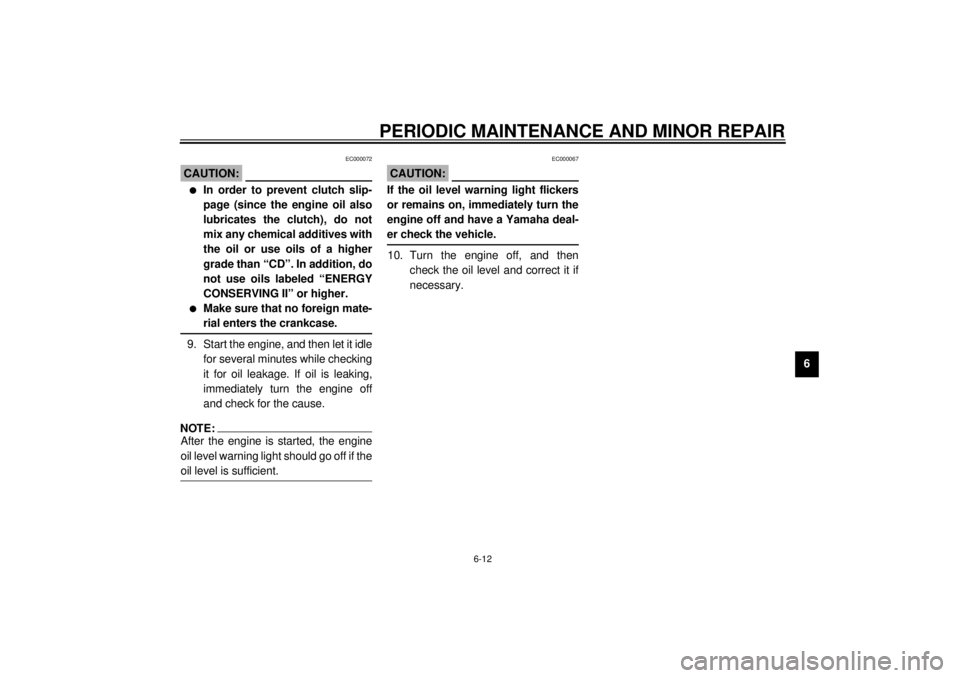
PERIODIC MAINTENANCE AND MINOR REPAIR
6-12
6
EC000072
CAUTION:@ l
In order to prevent clutch slip-
page (since the engine oil also
lubricates the clutch), do not
mix any chemical additives with
the oil or use oils of a higher
grade than “CD”. In addition, do
not use oils labeled “ENERGY
CONSERVING II” or higher.
l
Make sure that no foreign mate-
rial enters the crankcase.
@9. Start the engine, and then let it idle
for several minutes while checking
it for oil leakage. If oil is leaking,
immediately turn the engine off
and check for the cause.NOTE:@ After the engine is started, the engine
oil level warning light should go off if the
oil level is sufficient. @
EC000067
CAUTION:@ If the oil level warning light flickers
or remains on, immediately turn the
engine off and have a Yamaha deal-
er check the vehicle. @10. Turn the engine off, and then
check the oil level and correct it if
necessary.
E_3lr.book Page 12 Wednesday, November 22, 2000 4:10 PM
Page 56 of 110

PERIODIC MAINTENANCE AND MINOR REPAIR
6-13
6
EAU02975
Final gear oil The final gear case must be checked
for oil leakage before each ride. If any
leakage is found, have a Yamaha deal-
er check and repair the motorcycle. In
addition, the final gear oil must be
changed as follows at the intervals
specified in the periodic maintenance
and lubrication chart.
1. Place the motorcycle on the cen-
terstand.
2. Place an oil pan under the final
gear case to collect the used oil.3. Remove the oil filler bolt and drain
bolt to drain the oil from the final
gear case.
4. Install the final gear oil drain bolt,
and then tighten it to the specified
torque.
5. Add the specified amount of the
recommended final gear oil, and
then install and tighten the oil filler
bolt.
NOTE:@ GL4 is a quality rating. Hypoid gear oils
rated GL5 or GL6 may also be used. @
EW000066
WARNING
@ l
Make sure that no foreign mate-
rial enters the final gear case.
l
Make sure that no oil gets on
the tire or wheel.
@6. Check the final gear case for oil
leakage. If oil is leaking, check for
the cause.
1. Final gear oil filler bolt
2. Correct oil level
3. Final gear oil drain bolt
Tightening torque:
Final gear oil drain bolt:
23 Nm (2.3 m·kg)
Recommended final gear oil:
Hypoid gear oil SAE 80 (API GL4)
or multigrade hypoid gear oil
SAE 80W-90
Oil quantity:
0.2 L
E_3lr.book Page 13 Wednesday, November 22, 2000 4:10 PM